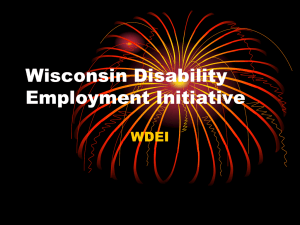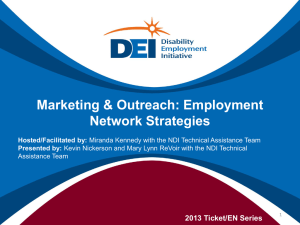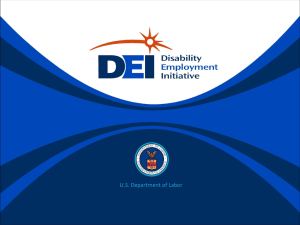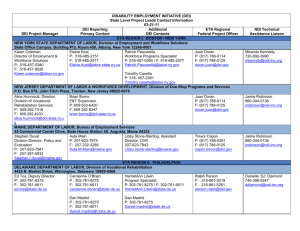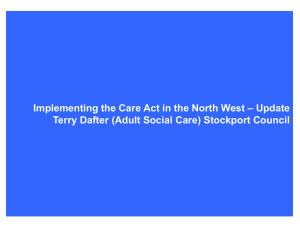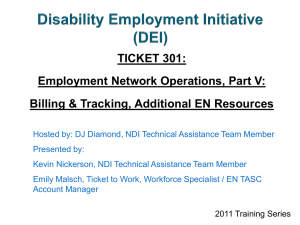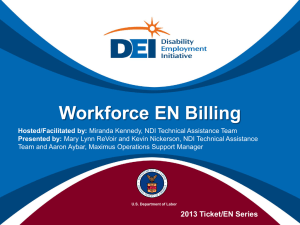(EN) Maturity Scale PowerPoint Presentation ()
advertisement
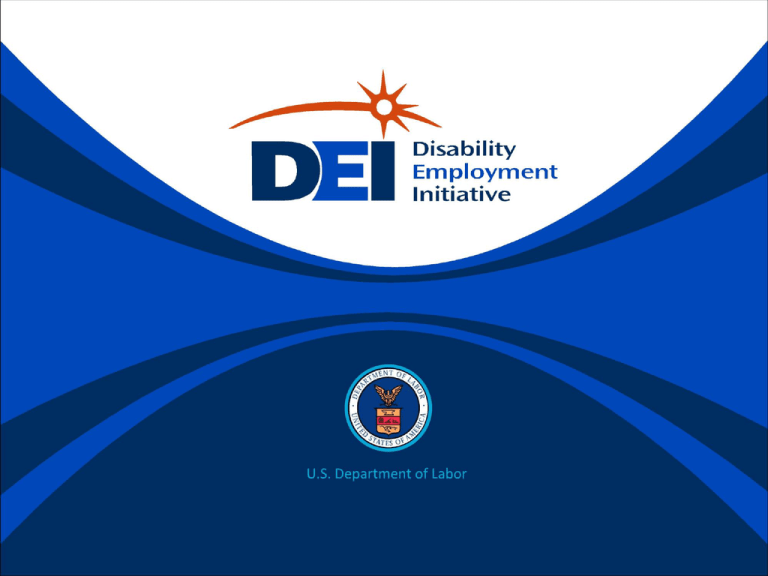
Workforce EN Maturity Scale Hosted/Facilitated by: Miranda Kennedy, NDI Technical Assistance Team Presented by: Kevin Nickerson and Mary Lynn ReVoir, NDI Technical Assistance Team U.S. Department of Labor 2013 Ticket/EN Series Disability Employment Initiative (DEI) According to the SGA, DEI Projects at the state level and/or local level participating LWIBs are required to become Employment Networks (ENs) under Social Security Administration’s (SSA’s) Ticket to Work Program. Training and Technical Assistance to DEI Projects in attaining Employment Network status and implementing effective EN operations is provided under U.S. DOLETA contract with NDI Consulting, Inc. and the National Disability Institute (NDI). Evaluation of the impact of the DEI Projects implementation and outcomes as Employment Network will be provided under U.S. DOL ODEP contract with Social Dynamics. Learning Objectives Upon completion of this training webinar, DEI grantees and participants and partners from the public workforce system will have the following: • An understanding of why becoming a Workforce EN is a promising practice for America’s Job Centers • An understanding of why DEI requires state and/or local WIB to become an EN and so much attention is placed on SSA Disability Beneficiaries • An understanding of the developmental stages an EN shall experience to become fully operational and successful as a mature EN Agenda • Why Employment Networks? • Why Job Centers as Employment Networks? • The Workforce EN Maturity Scale components • Next Steps • Q&A Subject Matter Expert Nickerson Kevin Nickerson DEI TA Team member P: (607) 272-7570 Ext. 136 E: knickerson@ndi-inc.org Why Employment Networks? Statement of Robert W. Williams Associate Commissioner, Office of Employment Support Programs before the House Committee On Ways and Means, Subcommittee on Social Security and the Subcommittee on Human Resources September 23, 2011 • Intent of Ticket to Work and Work Incentives Act “The Ticket program can be valuable even if it helps only a small number of beneficiaries return to work.” “Each disability award is expensive; on average, an award costs $250,000 in DI benefits and Medicare costs over a beneficiary’s lifetime.” “…it does not take many beneficiaries to return to work for those savings to add up…” • Provides choice to SSA Disability Beneficiaries The Employment and Poverty Scene November 2012 (U.S. Department of Labor ODEP) • Labor Force Participation People with disabilities: 20.7% People without disabilities: 69.2% • Unemployment Rate People with disabilities: 12.7% People without disabilities: 7.1% • Compared to individuals 18-64 years of age without a disability, people with disabilities are more than twice as likely to be living in poverty (Disability Statistics & Demographics Rehabilitation Research and Training Center, 2011). • The poverty rate for people receiving SSI benefits was 72% (Disability Statistics & Demographics Rehabilitation Research and Training Center, 2011, Livermore, 2009). Why job centers should be Employment Network (EN)? • Promising Practice stated by DOL – DOL released 12/5/12 TEN 14-12 plus 3 other TENs http://wdr.doleta.gov/directives/corr_doc.cfm?DOCN=4512 – Mathematic Research 2010 demonstrated SSA Beneficiaries use Job Centers • Aligns with the language and vision of WIA – Workforce investment system to provide core, intensive, and training services to those with barriers • Helps address budget crunches – Untapped revenue: potential to generate EN funds to partially or fully sustain DRC positions. EN funds could support service gaps, such as additional training funds. Incentives for work already being conducted. Ticket funds & other funding sources • Ticket funds are unrestricted funds. You decide. • Training and Employment Notice No. 20-07 clarifies that Ticket funding is an additional revenue source for Job Center delivery systems and is not considered program income and WILL NOT replace existing funding sources (i.e. funding is in addition to current funding sources, to be used how you see fit) • Braiding Medicaid funded services and Ticket to Work funds is not “double-dipping” Why DEI requires operating as an EN? • Responsive delivery system • Lessons learned from DOL Navigator Initiative – Services benefit from a subject matter expert – Relationship between DRC and serving job seekers with disabilities – The need to sustain DRC position • Changing workforce and growing customer base • Diverse Workforce initiatives by employers – Federal Hiring Executive Order 13548 to increase employees with disabilities within federal agencies – Private Sector values diversity How Ticket Fits Into DEI Strategies • Having Job Centers operate as ENs attracts customers who are on SSA disability benefits and sends a welcoming message to the disability community • Strengthens partnership and collaboration with Vocational Rehabilitation (VR) - helps build a responsive service delivery system • Promotes use of Integrated Resource Teams (IRTs) which increases successful employment outcomes for customer and Job Center programs • Contributes to the credit (data) of all programs involved in the employment outcome (i.e. WIA, Wagner-Peyser, VR) • Provides a revenue stream to assist DEI projects in developing sustainable positions within Job Centers beyond the life of the DEI grant • Asset Development strategies & Ticket go hand in hand How does Ticket apply to the DEI Youth projects? • Unique elements of Youth – Today’s youth have higher expectations than previous generations – Obtaining work earlier in life reduces window of unemployment time – Transition planning is stronger working together • “Most of the youth coming into the Job Centers are working with Vocational Rehabilitation (VR) and VR has their Ticket.” – Integrated Resource Teams (IRT) helps determine use of Partnership Plus gaining benefit to customer, VR and EN – The most appropriate, readily available services may initially be VR or it may initially be through the Job Center, especially in states where there is an order of selection (waiting list) for VR services Subject Matter Expert ReVoir Mary Lynn ReVoir DEI TA Liaison P: (515) 975-2344 E: mlrevoir@ndi-inc.org The Workforce EN Maturity Scale • Patience: – Takes time to complete orientation – Takes time to become fully operational – Outcome based design / reap benefits with outcomes • Investment: – Increasing employment for job seekers with disabilities will be worth the investment • Let’s take a look at the scale Review the Scale • 4 categories of competency – – – – Expertise Operational Problem-Solving Sphere of Influence • Progressive Phases • • • • Beginner Intermediate Advance Proficient / Mature • Each phase builds upon the preceding phase • Not necessarily at same phase at same time for each category • Corresponding Scale checklist available Phase I: Beginner • Understanding the “big picture” – Basics of Ticket and how to become an EN – Why job centers fit into the Ticket to Work program intent – How Ticket fits into the DEI project • Bringing the Ticket concept to state / local level – EN development / infrastructure – EN Business Model planning (refined over time) • Learning Ticket Basics • Applying and being awarded agreement as EN • Let’s look more closely Phase II: Intermediate – Post Award • Meeting your support team – National Workforce EN Team and services offered – Links to valuable resources • Implementing your EN operations – – – – – Security Clearance (needed if operating under RFQ) Infrastructure Set Up Individual Work Plan, assessments, Ticket assignments Internal marketing Tracking information • Building your Expertise Phase III: Advanced • Engaging entire job center operations – EN included in workforce marketing materials – Expertise is broadened throughout the job center • Policy and practices include EN operations – Practice of WIA and other case-management enrollment • Benefits Planning is incorporated into service delivery • Actively marketing your EN to disability community • Jointly promoting employment for persons with disabilities as coordinated effort with VR, other ENs, community providers Phase IV: Proficient / Mature • Mastered and embedded operations – Providing a responsive system – Able to continue operating even during changes • Achieving Ticket desired outcomes – Beneficiaries at Phase 2 or Outcomes – Job center EN receiving regular payments • Sustaining subject matter expert • Supporting benefits-planning • Capacity to fill unmet service gaps • Knowledge is wide spread and job center is viewed as value-added service for the disability community Workforce EN Maturity Scale Checklist • Tool serves as a checklist for Workforce EN • Compliments the Workforce EN Maturity Scale • Identifies competencies related to each phase • Can view snapshot of where you and where you are headed as an EN • Obtain from download today, off DEI Website, and/or from your TA Liaison • If you get stuck, ask for resources from your TA Liaison Summary In today’s presentation we covered the following: • Explanation of why Employment Networks are needed • Explanation of why Job Centers are good fit as an Employment Network and how the Ticket program fits with the DEI project • Introduced the Workforce EN Maturity Scale and related Checklist • Components that identify beginner, intermediate, and advanced and proficient levels of maturity Next Steps Attend the next training on Wednesday, January 23rd from 3pm to 4pm EDT Workforce Employment Network (EN) Business Plan The NDI team will be providing the “Workforce EN Business Plan”” webinar training to assist job centers in developing a successful business plan for their EN operations. This training will be presented by Kevin Nickerson and Mary Lynn ReVoir and will be hosted by Miranda Kennedy with the NDI Technical Assistance Team. This webinar will cover the following information: • Recent Ticket efforts related to job centers operating as Employment Networks • Examples of various EN Business Models • Explanation and tools to develop a business plan for your Employment Network Questions/Comments If you have a comment or question you can: A: Submit it to the host in writing via the Chat or Q&A Box to the right, or… B: Click on the “raise hand” icon to have your line un-muted and ask your question/make your comment. Contact Information Kevin Nickerson NDI Technical Assistance Team P: (607) 272-7570 Ext. 136 E:knickerson@ndi-inc.org Mary Lynn ReVoir NDI Technical Assistance Team P: (515) 975-2344 E: mlrevoir@ndi-inc.org
